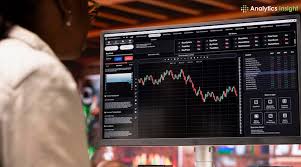
How Crypto Trading Works
The world of cryptocurrency has gained significant attention over the past few years. With Bitcoin reaching unprecedented prices and numerous other cryptocurrencies emerging in the market, many individuals are eager to understand how crypto trading works. In this guide, we will dive deep into the mechanisms behind crypto trading and provide insights to help you navigate this complex, yet rewarding, financial landscape.
For those interested in the intersection of technology and finance, you might want to check out this interesting piece on how crypto trading works https://insidehpc.com/2021/01/fpga-maker-achronix-to-list-on-nasdaq-through-merger-with-ace-convergence/ through a merger, which showcases how technological advancements are often intertwined with investment opportunities.
What is Crypto Trading?
Crypto trading involves buying, selling, or exchanging cryptocurrencies in digital marketplaces, known as exchanges. Similar to stock trading, the objective is to purchase cryptocurrencies at a lower price and sell them at a higher price to make a profit. However, unlike traditional currencies or stocks, cryptocurrencies are decentralized and operate on blockchain technology, which adds a layer of complexity to trading practices.
Types of Crypto Trading
There are several different approaches to cryptocurrency trading, and each has its own set of strategies and methodologies. Here are three of the most common types:
1. Day Trading
Day trading involves making multiple trades throughout a single day, taking advantage of short-term price fluctuations. Traders who adopt this approach use technical analysis, charts, and indicators to identify potential entry and exit points. This method requires a keen understanding of market trends, as well as the ability to act quickly.
2. Swing Trading
Swing traders typically hold their positions for several days or weeks, capitalizing on price swings during that timeframe. This strategy involves a blend of technical and fundamental analysis, with traders looking to identify patterns and market behavior to select optimal trade opportunities. Swing trading is generally less intense than day trading but still requires ongoing research and market monitoring.
3. HODLing

The term “HODL” originated from a misspelled post on a Bitcoin forum and has since evolved into a strategy for long-term investment. HODLers buy and hold cryptocurrencies for an extended period, ignoring short-term market fluctuations. This approach is based on the belief that the value of cryptocurrencies will appreciate significantly over time.
Understanding Cryptocurrency Exchanges
To engage in crypto trading, you must use a cryptocurrency exchange. These platforms act as intermediaries, allowing users to buy and sell digital currencies. There are two main types of exchanges: centralized exchanges (CEX) and decentralized exchanges (DEX).
Centralized Exchanges (CEX)
Centralized exchanges are platforms that facilitate trading by acting as a middleman. Users create accounts on these exchanges, deposit their funds, and can trade various cryptocurrencies. CEXs offer higher liquidity and user-friendly interfaces, making them popular among beginners. However, they face issues related to security and regulation since they hold users’ funds and personal information.
Decentralized Exchanges (DEX)
In contrast, decentralized exchanges allow users to trade directly with each other without a central authority. DEXs operate on blockchain technology and use smart contracts to facilitate transactions. While this approach enhances security and privacy, DEXs typically have lower liquidity and may offer a steeper learning curve for new traders.
Analyzing the Market
Successful crypto trading relies heavily on market analysis. Traders examine various factors that influence cryptocurrency prices to make informed decisions. Here are two key methods of market analysis:
1. Fundamental Analysis
Fundamental analysis involves evaluating the intrinsic value of a cryptocurrency by analyzing factors such as technology, team, market demand, and regulatory developments. By understanding these aspects, traders can gauge whether a cryptocurrency is undervalued or overvalued and make strategic investment decisions based on their findings.
2. Technical Analysis

Technical analysis is the study of historical price movements and trading volumes. Traders use charts, patterns, and indicators to predict future price movements based on past behavior. Common tools used in technical analysis include moving averages, relative strength index (RSI), and Fibonacci retracements. This method is particularly popular among day traders and swing traders.
The Risks of Crypto Trading
While crypto trading can be lucrative, it is also associated with a range of risks. Some of the most significant risks include:
1. Volatility
The cryptocurrency market is known for its significant price fluctuations. While this volatility can create opportunities for profit, it also means the potential for substantial losses. Traders must be prepared to navigate this unpredictable landscape.
2. Security Risks
Cybersecurity threats are a prevalent concern in the cryptocurrency space. Hacks, scams, and phishing attacks can lead to the loss of funds. It is crucial for traders to use secure wallets, enable two-factor authentication, and follow best practices when it comes to security.
3. Regulatory Risks
Government regulations regarding cryptocurrencies vary across jurisdictions and continue to evolve. A sudden change in regulatory policies can drastically impact the market and the legal status of certain cryptocurrencies. Traders should stay informed about the legal landscape affecting their investments.
Conclusion
Understanding how crypto trading works requires knowledge of market dynamics, trading strategies, and risk management. Whether you choose day trading, swing trading, or HODLing, it is essential to educate yourself and develop a robust trading plan. As the crypto market continues to evolve, staying informed about trends and best practices will be vital for success. By approaching crypto trading with caution and diligence, you can unlock the potential for profitability in this exciting financial arena.
